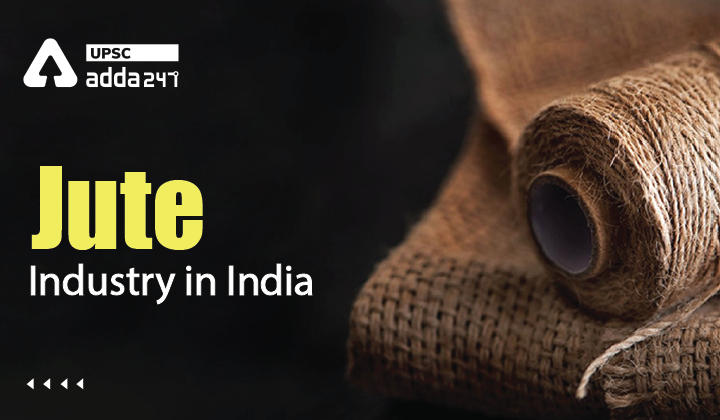Table of Contents
Jute Industry in India UPSC: Relevance
- GS 2: Government policies and interventions for development in various sectors and issues arising out of their design and implementation.
Jute industry in India: Context
- Recently, the jute sector in West Bengal is facing a major crisis, thus impacting the livelihood of thousands of workers and farmers.
Recent issue in jute industry
Issue relating to procurement
- The recent issue of the sector is the procurement of raw jute at a higher cost but the final output is being sold at higher rates.
- The government procures raw jute from farmers at a fixed Minimum Support Price (MSP), which reaches the mill at Rs 700 more than the MSP for the final product.
- This difference in the price is majorly because jute mills do not procure raw material directly from the farmers owing to the distance from farmers. Also, the process of procurement takes time.
- Moreover, no single farmer produces enough jute to meet the entire demand of a mill. It gives breeding ground for middlemen or traders who then procure raw jute from multiple farmers and then trade it to the mills.
Issues related to climate
- Cyclone Amphan of 2020 resulted in lower production of Jute.
- Commission for Agricultural Costs and Prices (CACP) said reported that a lower quality of jute fibre was produced in 2020-21 due to the cyclone.
- The landfall of cyclone has caused the problem of waterlogging and farmers had to harvest their crops prematurely.
Issues related to hoarding
- These issues were accompanied by hoarding at all levels – right from the farmers to the traders.
Jute industry in India
- India is the largest producer of Jute followed by Bangladesh and China.
- Jute is also known as the golden fibre and is one of the most significant industries after cotton in India.
- Bangladesh, however, tops the list in terms of acreage and trade as it accounts for three-fourths of the global jute exports while India’s contribution is only 7%.
- The major jute producing states are West Bengal, Bihar, Odisha, Assam, Andhra Pradesh, Meghalaya and Tripura.
- Importantly, over 99% of India’s total production is held by West Bengal, Bihar and Assam.
भारत में जूट उद्योग: इतिहास, मुद्दे तथा सरकार द्वारा उठाए गए कदम
Climate condition required for jute
- Jute is majorly grown in the delta shared by West Bengal and southwest Bangladesh, and in parts of Assam, Meghalaya and Tripura.
- It grows in a warm and humid climate with temperatures between 24° C to 37° C.
- Jute is totally biodegradable and recyclable, and does not produce toxic gases while burnt.
- It not only consumes carbon dioxide and releases oxygen but also increases soil fertility if grown in crop rotations.
Jute industry after partition
- Earlier, Calcutta Mills had become the world’s largest jute producer in 1910, providing employment to more than 300,000 people.
- Also, during the Crimean War and later in World War I, the jute was found useful in military works and growing demand helped Bengal to establish its monopoly over it.
- With the partition of Bengal into West Bengal and East Pakistan (today’s Bangladesh) in 1947, the Indian Jute industry was severely hit as over 75% of the jute-growing land went to East Pakistan.
Government initiatives for jute industry
- Jute Packaging Materials Act, 1987: The provisions of the Jute Packaging Material (Compulsory use in Packing Commodities) Act, 1987 made it compulsory to pack 100% production of foodgrains and 20% sugar production in jute bags.
- Jute SMART: In 2016, Jute SMART was launched to bring transparency to the jute sector.
- The use of Jute Geo-textiles is being promoted.
- The Jute Geo-Textiles (JGT) can be made through the special treatment and weaving processes. JGT can be applied to many fields including soil erosion control, civil engineering, protection of river banks and road pavement construction.
- R&D is being promoted for the use of jute in different sectors like automobiles, roads, construction etc.
- New retting technology have been developed and trials of the same is being done
- Efforts are being done to modernize the jute industry.
- Efforts are being done to explore new uses of jute fibre on mass scale through National Institute of Design (NID).
- The Jute Diversified Products (JDPs) are being promoted for domestic consumption as well as for exports.
- Jute Technology Mission: The Jute Technology Mission has been a major component of the National Jute Policy and is the vehicle for implementation of multifarious programmes in the jute sector.
Read UPSC favourite topics





 TSPSC Group 1 Question Paper 2024, Downl...
TSPSC Group 1 Question Paper 2024, Downl...
 TSPSC Group 1 Answer key 2024 Out, Downl...
TSPSC Group 1 Answer key 2024 Out, Downl...
 UPSC Prelims 2024 Question Paper, Downlo...
UPSC Prelims 2024 Question Paper, Downlo...




